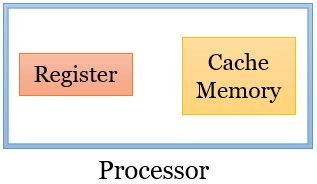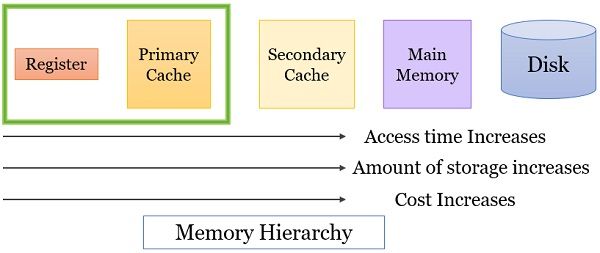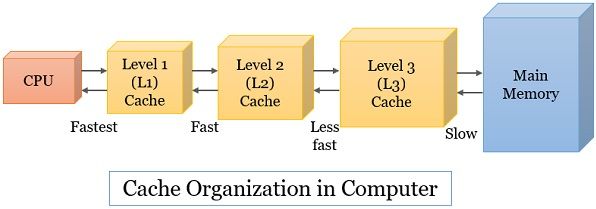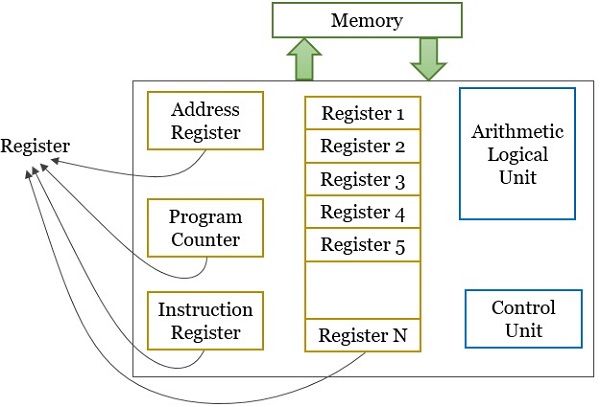 Cache memory and register both are the memory units of the computer. But they are not the same in terms of speed, size, access time, etc. Cache memory is an individual memory unit that stores the data that has been used recently by the processor. On the other hand, the register is a high-speed storage element that holds the data that the CPU is currently processing.
Cache memory and register both are the memory units of the computer. But they are not the same in terms of speed, size, access time, etc. Cache memory is an individual memory unit that stores the data that has been used recently by the processor. On the other hand, the register is a high-speed storage element that holds the data that the CPU is currently processing.
Whenever the processor fetches any instruction or the associated data from the main memory into the processor chip (registers), it stores a copy of it into the cache memory. However, when the processor fetches operands from memory on which ALU will perform an operation, then it stores them in registers.
Registers are smaller and faster than cache memory. If we count both the memory units on the memory hierarchy, then registers are on the top of the memory hierarchy.
What is Memory Hierarchy?
In a computer system, there are different kinds of memory units. These memory units are organized in such a way that the memory nearer to the processor would have less access time.

Content: Cache Memory Vs Register
Comparison Chart
| Basis for Comparison | Cache Memory | Register |
|---|---|---|
| Description | Cache memory is a smaller and faster memory unit of the computer | Register is the smallest and fastest memory unit of the computer |
| Access | Access time is comparatively longer | Access time is shorter than cache unit |
| Location | It is a separate memory unit. | It is a memory unit located in the CPU. |
| Size | 2 KB to a few MB | One word of data i.e. up to 64 bits |
| Stores | It stores recently used data | It stores data that the CPU is currently processing |
| Used | Whenever the processor reads some data from the main memory it places a copy of it in the cache | Whenever the processor identifies operands from memory it places them in registers |
| Types | L1, L2, and L3 | MAR, MBR, PC, AC, etc. |
What is Cache Memory?
Cache memory is an individual memory unit that is adjunct to main memory. Comparatively, it is smaller and much faster than the main memory. This is because it is tightly coupled with the processor and implemented on the processor chip itself.
Now, as it is smaller than the main memory, it can not hold the entire program at once. So, it holds sections of the program (set of instructions) that are currently in execution. Along with the set of instructions, it also holds the data associated with it.
How does Cache Memory Works?
In the beginning, the program and the data associated with the program lie in the main memory, and the cache is empty.
When the processor starts executing the program, it reads the instruction from the main memory and places it on the processor chip (registers). Along with this, it places a copy of each instruction on to the cache.
If execution of particular instruction requires any associated data, the processor access it from the main memory and places a copy of it on the cache memory also.
Now consider these instructions have to be executed repeatedly (as in the case of a loop). If the instructions are available in the cache, then the processor will directly access them from the cache memory. As the cache is faster than the main memory, it will ultimately fasten the execution.
Types of Cache Memory
There are multiple levels of caches. We can classify them on the basis of their size and speed.

- L1 Cache: It is the smallest among all the caches and is much faster than any other cache.
- L2 Cache: Comparatively, the L2 cache is larger and slower than the L1 cache.
- L3 Cache: It is larger and slower than both the L1 and L2 cache.
What is Register?
Registers are inbuilt memory units on the processor chip. It is the smallest memory unit of any computer. The memory size of a register is from 2 MB up to a few KB. It can store one word of data. As it is the nearest memory to the processor, it has the fastest access time.
All CPUs have some registers that store instructions, variables, and temporary results. CPU also have some special registers for storing special data.
How does Register Works?
A program is a set of instructions that are brought to the main memory for execution. Now accessing an instruction from the main memory takes longer time than its execution. Thus, the CPU uses registers to hold the instructions, key variables and temporary results.

In this way, during program execution, each time, an instruction or a word from the main memory is brought into the register. The CPU then access the instructions from the register and perform the desired action. CPU even stores temporary results and final results into the registers and from the register back to the main memory.
Types of Registers
- General Purpose Registers
We also refer to it as a processor register. They serve a variety of functions such as including holding operands that have been loaded from memory for processing. - Memory Buffer Register (MBR)
It stores a word fetched from the main memory or I/O unit. It even stores the word that the process has to send back to the main memory or I/O unit. - Memory Address Register (MAR)
It specifies the address in a memory from where the word will be read into MBR or where the word from MBR will be written into memory. - Instruction Register (IR)
It holds an 8-bit opcode (machine instruction) that is currently being executed. - Instruction Buffer Register (IBR)
The IBR register temporarily holds the right-hand instruction from the word in the memory. - Program Counter (PC)
PC holds the memory address of the instruction that has to be fetched next for execution. - Accumulator (AC)
Accumulator holds temporary operands and results of any ALU operations.
Key Differences Between Cache Memory and Register
- Cache memory is a smaller and faster memory unit of a computer. However, the register is even shorter and faster than cache memory.
- As cache memory is tightly coupled with the processor and is implemented on the processor chip itself thus, access time to the cache memory is less. Even though the registers are also present on the processor chip itself but the access time of the register is even shorter than the cache memory.
- Cache memory is an individual memory unit present on the processor chip. On the other hand, registers are the smallest high-speed component present on the processor chip.
- The cache memory in any computer can be from 2 MB up to a few KBs. Whereas registers are the smallest memory unit that can store up to one word of data, i.e. up to 64 bits.
- CPU uses cache memory to store recently used data. On the other hand, the CPU use registers to store operands that the CPU is currently processing.
- Whenever the processor reads any instructions or data from the main memory, it stores a copy of it into the cache memory. Conversely, when the processor identifies operands out of instruction or associated data, it stores them on registers.
- We can classify cache on multiple levels, such as L1, L2, and L3. However, a CPU has several types of registers, such as general-purpose registers, MAR, MBR, IR, IBR, AC, PC etc.
Conclusion
Only the primary cache (L1) and all kinds of registers are present on the processor. However, the registers are the smallest and most high-speed component of any computer. Although both of them are smaller memory units of computers, they are used for different purposes. The cache is used for storing recently used instructions and data, whereas the processor use registers to store instruction and data that it is currently processing.
Leave a Reply